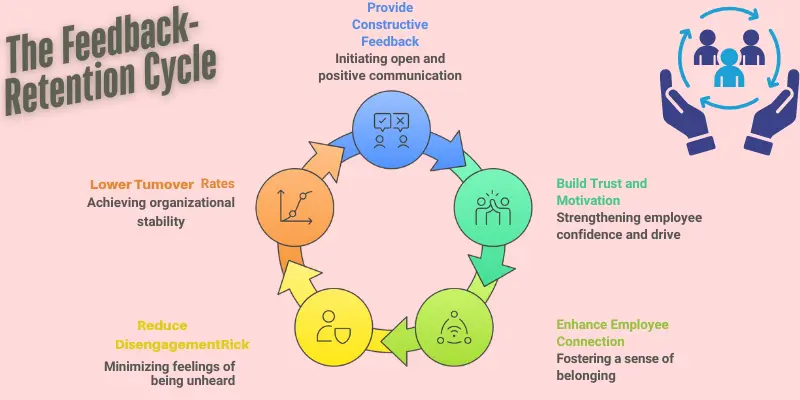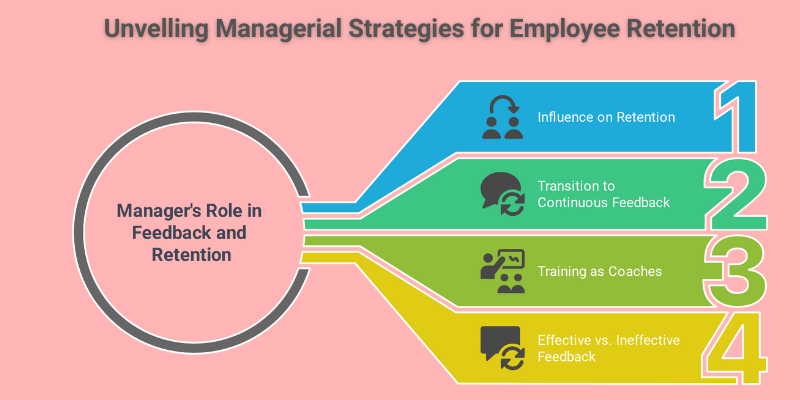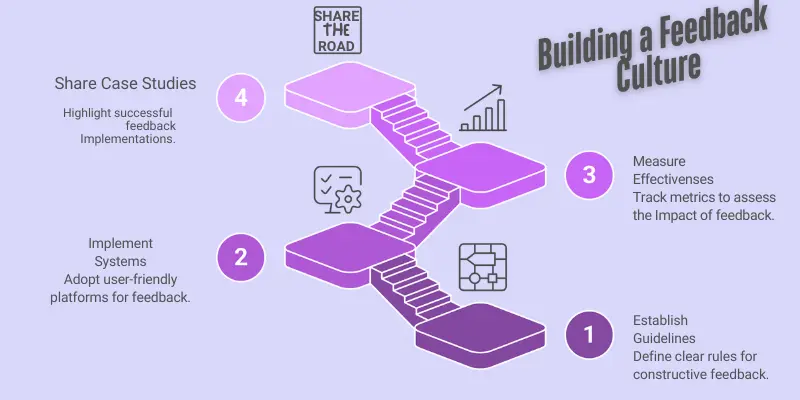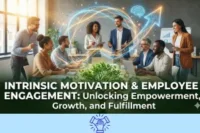Does Feedback Really Improve Employee Retention? (Here’s What the Data Says)
Published: 15/04/2025
Imagine this: You’ve hired and trained a new employee, only to have them leave unexpectedly. No warning, no clue they were unhappy. What went wrong?
If this sounds familiar, you’re not alone. Employee turnover is a costly challenge, with U.S. businesses losing nearly $600 billion annually due to high turnover. But here’s the surprising part—employee retention often has more to do with feedback than paychecks. In fact, companies with regular feedback systems see 14.9% lower turnover rates, according to Gallup. Yet, Work Institute research shows that half of employees say they rarely receive meaningful feedback.
What if feedback was the key to keeping your best employees around, without having to increase salaries or offer endless perks?
In this post, we’ll break down the data behind feedback and retention, explore why the quality of feedback matters, and share actionable strategies you can use today to improve retention in your organization.
Ready to learn how feedback can help you retain top talent? Let’s dive in!
The Current State of Employee Retention
Employee retention has become a top concern for many organizations. With changing work expectations and a competitive job market, keeping valued employees has never been more challenging. High turnover affects company performance, morale, and finances. By understanding the current state of retention, businesses can begin taking the steps needed to create a more stable workforce.
Turnover Challenges:
- Many industries face increasing difficulty in retaining top talent due to growing competition and shifting employee priorities.
- Employees are seeking roles that align more closely with their values, offer growth opportunities, and provide flexibility.
Retention Statistics by Industry:
- Hospitality and retail sectors experience turnover rates as high as 70% annually, while more stable fields like healthcare still report rates around 20–30%.
- Consistently high turnover across industries underscores the need for better strategies to keep employees engaged and committed.
Costs of High Turnover:
- Replacing an employee can cost upwards of 30–50% of their annual salary, not to mention the loss of institutional knowledge.
- Indirect costs include reduced productivity, disruption to team dynamics, and longer project timelines.
Common Departure Factors:
- Lack of clear career progression or development opportunities often leads employees to move on.
- Poor management or ineffective communication contributes to disengagement.
- Limited work-life balance or rigid scheduling drives workers to seek more accommodating employers.
The Feedback-Retention Connection: What the Research Shows
Effective feedback has been consistently linked to improved employee retention. By fostering open communication and providing constructive input, organizations can help employees feel more valued, understood, and engaged. This, in turn, significantly reduces the likelihood of turnover.

Key Statistics Linking Feedback to Retention:
Gallup found that companies with well-structured feedback systems see turnover rates drop by 14.9%.
- According to Textio, employees who receive low-quality feedback are 63% more likely to leave their jobs within a year.
- Weekly meaningful feedback keeps 80% of employees fully engaged (Gallup).
- Allvoices reported that 41% of employees have left a job because they felt unheard or ignored.
How Feedback Affects Decisions to Stay or Leave:
- Constructive feedback builds trust and motivates employees, leading them to stay longer.
- Consistent, meaningful input helps employees feel more connected and valued within the organization.
- When employees don’t receive proper feedback—or worse, receive only negative or unclear feedback—they often disengage and begin searching for other opportunities.
Quality Matters: Not All Feedback is Created Equal
Not all feedback has the same impact—some types of feedback can strengthen employee engagement, while others may push employees to leave. The quality of feedback matters more than just the frequency. Constructive, timely, and actionable feedback is far more effective at retaining talent and fostering growth than vague or poorly delivered feedback.
High-Quality Feedback Characteristics:
It’s clear, specific, and directly relates to the employee’s role and goals.
- Delivered consistently and promptly rather than sporadically or only during performance reviews.
- Emphasizes personal and professional development, not just pointing out mistakes.
Risks of Poor-Quality Feedback:
- Generic or overly critical feedback without actionable suggestions can lead to frustration and disengagement.
- Employees who feel misunderstood or unfairly judged are more likely to consider leaving.
Impact on Diverse Employee Groups:
Research highlights that underrepresented employees often receive less detailed or less constructive feedback than their peers.
- This can exacerbate feelings of exclusion and negatively affect retention within diverse teams.
The Manager’s Role in Feedback and Retention
Managers play a pivotal role in shaping employee experiences. Their approach to feedback can either strengthen retention or drive employees away. By embracing continuous feedback and focusing on meaningful dialogue, managers can create an environment where employees feel supported, valued, and motivated to stay.

How Managers Influence Retention:
Open and honest feedback builds trust, strengthens relationships, and fosters a sense of belonging.
- Proactive managers identify concerns early, address them promptly, and prevent disengagement.
From Annual Reviews to Continuous Feedback:
- Moving from once-a-year evaluations to ongoing feedback provides employees with timely guidance.
- Regular check-ins help managers adjust goals, offer recognition, and address issues before they escalate.
Training Managers as Coaches:
- Providing managers with coaching skills helps them guide employees toward growth and development.
- Managers who actively listen, show empathy, and offer actionable advice become reliable mentors.
Effective vs. Ineffective Feedback Examples:
- Effective: “I appreciate your effort on this project. Next time, consider adding more detailed explanations to your reports.”
- Ineffective: “You need to do better.”
- Effective feedback is specific, constructive, and offers clear guidance for improvement, whereas vague or critical feedback leads to confusion and dissatisfaction.
Building a Feedback Culture That Retains Talent
A strong feedback culture doesn’t happen overnight. It requires clear steps, the right tools, and a commitment to ongoing improvement. By fostering open communication, using supportive systems, and learning from real-world examples, organizations can create an environment where employees feel valued and motivated to stay.

Steps to Create a Feedback Culture:
Establish clear guidelines for providing constructive feedback.
- Encourage frequent, two-way conversations between employees and managers.
- Promote a growth mindset where feedback is seen as an opportunity, not a critique.
Implementing Feedback Systems and Tools:
- Adopt user-friendly platforms that make it easy to give and receive feedback.
- Set up regular check-in processes, like monthly performance snapshots.
- Integrate feedback into daily workflows rather than waiting for formal reviews.
Measuring Effectiveness:
- Track key metrics like employee engagement scores and turnover rates.
- Collect anonymous feedback to gauge employee satisfaction with the current system.
- Regularly review and adjust processes based on measurable outcomes.
Case Studies:
- Highlight companies that reduced turnover by embracing real-time feedback loops.
- Share stories of how transparent communication improved employee morale and retention.
- Provide examples of innovative approaches that led to measurable success.
Common Mistakes in Feedback Practices
While feedback can be a powerful tool for improving retention, certain mistakes can undermine its effectiveness. Identifying and avoiding these common errors is essential for building trust and engagement among employees.
Infrequent or Delayed Feedback:
- Waiting too long to provide feedback can make it less relevant and less impactful.
- Employees need timely input to improve and stay motivated.
Vague, Non-Actionable Feedback:
- General statements like “You need to improve” don’t provide clear direction.
- Feedback should be specific and include steps employees can take to grow.
Focusing Only on Negative Aspects:
- Constantly pointing out flaws without acknowledging strengths can lower morale.
- Balancing constructive criticism with positive reinforcement helps maintain motivation.
One-Way Feedback Without Dialogue:
- Feedback should be a conversation, not just a lecture.
- Encouraging employees to share their perspectives fosters collaboration and trust.
Failing to Follow Up:
- Feedback sessions without follow-up actions leave employees feeling unsupported.
- Regular check-ins after feedback ensures progress and shows that managers care about employee growth.
Practical Strategies for Implementing Effective Feedback
Creating a feedback-rich environment requires practical steps and resources that make the process consistent, fair, and constructive. By adopting structured methods and fostering a safe space for honest communication, organizations can ensure feedback is not only heard but also valued.
Structured Feedback Approaches:
- Schedule regular one-on-ones to discuss performance and goals.
- Use a standardized framework (e.g., the SBI method: Situation, Behavior, Impact) to deliver feedback in a clear, actionable manner.
- Encourage team leaders to keep feedback records to track progress over time.
Tools and Technologies:
- Implement feedback platforms that allow employees to share input easily.
- Use goal-tracking software to align feedback with individual and team objectives.
- Employ pulse surveys to gather real-time insights on how feedback is received and applied.
Training Programs:
- Offer workshops to help managers refine their feedback delivery skills.
- Provide role-playing exercises to practice giving both positive and constructive feedback.
- Encourage ongoing education on diversity and inclusion to ensure feedback is fair and unbiased.
Creating Psychological Safety:
- Make it clear that feedback is a normal part of growth, not punishment.
- Encourage open communication by showing appreciation for honest input.
- Train leaders to respond non-defensively and actively listen to employee concerns.
Measuring the Impact of Feedback on Retention
Evaluating the effectiveness of feedback initiatives is essential to understanding how they influence retention and overall workforce health. By tracking specific metrics and analyzing results over time, organizations can refine their approach and see tangible improvements in employee satisfaction, performance, and loyalty.
Key Metrics to Track:
- Turnover rates before and after implementing feedback programs.
- Employee engagement scores and changes in survey results.
- Performance review completion rates and trends in feedback frequency.
Calculating ROI:
- Compare retention costs (like recruitment and onboarding expenses) before and after feedback implementation.
- Measure productivity gains tied to higher employee satisfaction.
- Consider indirect benefits such as reduced absenteeism and increased team morale.
Timeline for Improvements:
- Retention benefits often begin to show within six months to a year.
- Short-term metrics (e.g., immediate feedback survey responses) can indicate if the initiative is on the right track.
- Long-term data provides a more accurate picture of the sustained impact on retention.
Additional Benefits:
- Higher engagement levels lead to more innovation, better customer service, and stronger teamwork.
- Improved performance as employees better understand expectations and feel more supported.
- Greater loyalty and a stronger company culture, making the organization a more attractive place to work.
| Key Takeaways |
|---|
|
Turning Feedback Into Your Retention Superpower
Creating a culture of effective feedback is an ongoing commitment that requires buy-in from everyone. Leaders need to set the example, managers must act as coaches, and employees should feel empowered to grow.
Start by asking: How do employees view their feedback? Is it fair, useful, and timely for all, including underrepresented groups? Are managers equipped to provide meaningful guidance?
By tracking results and return on investment, you’ll see the benefits. Retention may take time, but improved engagement, performance, and morale can emerge quickly.
The evidence is clear: feedback helps improve retention. The real challenge is determining if your organization is prepared to embrace a new approach and unlock the benefits of a more engaged, high-performing, and loyal team.
Your Next Steps
Now is the time to make feedback a core part of your retention strategy. Start by reviewing current practices, training managers, and fostering a culture where meaningful feedback helps employees thrive.
We’d love to hear your experiences. What’s worked well for your team? What obstacles have you faced? Share your thoughts in the comments.
Frequently Asked Questions: Feedback and Employee Retention
Turns out, it really does. The numbers don’t lie:
- Companies that give meaningful feedback see 15% fewer employees quitting (Gallup).
- Employees who get vague or unhelpful feedback are 63% more likely to leave within a year (Textio).
So feedback isn’t just some HR checkbox—it’s often the difference between someone sticking around or walking out the door.
You’ll see engagement boost quickly, but actual retention improvements take 3-6 months. It’s like exercise – you feel better fast, but visible results come later.
Early signs (like survey scores jumping) reliably predict fewer quits down the road.
Yes, but delivery varies:
• Creatives → Collaborative discussions
• Technical roles → Specific, actionable tips
• Frontline staff → Immediate coaching
The bottom line? Good feedback = better retention across all fields.
Weekly. That’s when 80% of employees feel truly engaged (Gallup). While yearly reviews still matter, quick regular check-ins work best.
• Creative roles → Try weekly brainstorming chats
• Technical teams → Bi-weekly skill-building feedback
• Customer-facing staff → Real-time coaching moments
Adjust as needed, but keep it consistent.
You need both, but in the right mix:
• Praise (3x more often) → Builds confidence and shows what’s working
• Constructive notes → Helps growth when delivered supportively
The magic happens when employees feel:
✓ Recognized for their wins
✓ Supported in their growth
Quick wins (1-3 months):
- Happier teams
- Better communication
Steady gains (3-6 months):
- More engaged employees
- Fewer considering quitting
Long-term wins (6-12 months):
- Lower turnover
- Stronger culture
Good things take time—but they’re worth waiting for.

- Be Respectful
- Stay Relevant
- Stay Positive
- True Feedback
- Encourage Discussion
- Avoid Spamming
- No Fake News
- Don't Copy-Paste
- No Personal Attacks

- Be Respectful
- Stay Relevant
- Stay Positive
- True Feedback
- Encourage Discussion
- Avoid Spamming
- No Fake News
- Don't Copy-Paste
- No Personal Attacks





